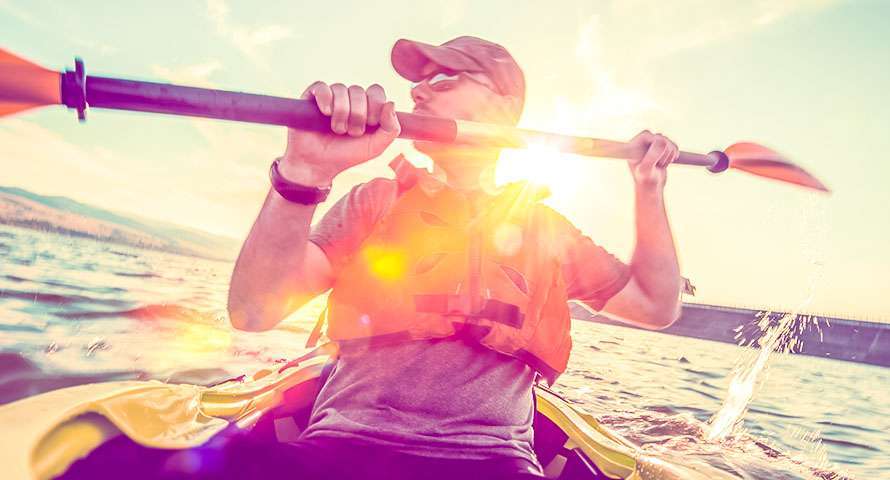You might be wondering why on earth you want to paddle in reverse? That is a fair question and it deserves a proper answer. Forward paddling is definitely the most popular form of paddling strokes, but that does not mean you should ignore the importance of reverse paddling.
Reverse Paddling Is Often Used In Situations Like These –
Here are some hypothetical situations when your reverse paddling skills may come handy –
1. Situation 1: Entering a Narrow Creek
Imagine entering a narrow creek and then after a few minutes, you eventually realized that you have made a terrible mistake. Since there is no way you can move forward, the only option left for you to go backward. But how? Since the passage is narrow, there is no way you can turn your kayak around. This is a kind of situation, where paddling in reverse can save your skin.
2. Situation 2: Your Friend’s Boat Has Capsized
What happens if your friend makes a terrible mistake and ends up capsizing his boat? Believe me, you would not have the time to turn the boat around to rescue him. The fastest way to reach to your friend in trouble is by paddling in reverse.
Just like forward paddling, reverse paddling is an equally important paddling technique that all kayakers should be well aware of. While you are at sea, your paddling skilling and kayaking knowledge will be tested by mother nature and which is why you need to master the art of paddling in reverse otherwise you will soon have to face the wrath of nature.
Factors to Consider While Paddling in Reverse
There are a number of factors that you need to consider while trying to paddle in reverse. Ignoring these factors can lead to a major disaster –
1. Hold The Paddle Lightly
Some people make the mistake of holding the paddle too hard while trying to paddle in reverse. You don’t have to put extra efforts just because you are paddling in reverse. The technique remains more or less the same and that means, you don’t have to change the way you hold a paddle. By lightly holding the paddle, you will have more control over the kayak.
2. Use the Back of the Paddle Blade
When you are kayaking in reverse, you need to make sure that the back of the paddle blade is being utilized. Unlike in forward paddling where you need to place the paddle blade near your feet, in case of backward paddling, you will have to put the paddle blade near the hips. Once you have positioned the paddle blade correctly, you will have to push the paddle forward.
3. Don’t Put Yourself in Harm’s Way
While paddling backward, you need to make sure that your elbows are already bent otherwise you are going get yourself hurt one way or the other. Always look over your shoulder when you are paddling backward otherwise you are going to run into some sort of trouble. Always remember that reverse paddling is far more complicated than it appears and that means, you will always have to stay vigilant.
Backward Paddling Tips
Backward paddling has a number of benefits. The chief among them is the fact that reverse paddling helps toughen and strengthen shoulder muscles that tend to get injured while doing forward paddling. Moreover, it helps kayakers to get greater control over different complex moves like back surfing and back ferries.
Listed are some tips that might help you paddle in reverse –
1. Do it on Flatwater First
There is no way you can expect to paddle in reverse in stormy weather or choppy water. Things will definitely go horribly wrong. So, the beginners must start practicing reverse paddling in calm flat water. If you get tired while doing reverse paddling for just 0 minutes, it is a good indicator that muscles are not fully prepared to do reverse paddling for 30 minutes or longer. It also indicates another sinister possibility that you might end up sustaining a shoulder injury in the process and that means, you will have to be extra careful while practicing. Take it slow. No need to rush at all. It is okay to lose control at the initial stage of reverse paddling but don’t let that unsettle you. Continue making correction strokes until you get it right.
2. Use Bow Rudder & Bow Draw
As you’re going backward, practice corrections with both a bow rudder and bow draw. The bow draw moves the bow to your blade. The bow rudder moves the bow away.
3. Maintain Your Speed
You need to gradually increase the speed while making correction strokes you might pull off a wave. In such cases, you might have to use both the bow draw and the rudder to get the boat under control.
Most people don’t think about steering in reverse until back surfing, and then it’s too late…you’re off the wave!
4. Do it on Rivers
Once you have mastered the art of backward paddling on flat water, you will have to test your skills on rivers. There is virtually no other way to develop your back surfing skills unless you decide to take on the challenge of doing backward paddling on a river.
It is a fact that backward paddling is definitely not an easy feat. It involves a steep learning curve and which is why some people get frustrated. But over time, you will have better control. All you have to do is to practice a lot and that is all.

